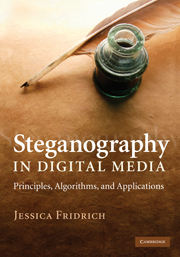Book contents
- Frontmatter
- Dedication
- Contents
- Preface
- Acknowledgments
- 1 Introduction
- 2 Digital image formats
- 3 Digital image acquisition
- 4 Steganographic channel
- 5 Naive steganography
- 6 Steganographic security
- 7 Practical steganographic methods
- 8 Matrix embedding
- 9 Non-shared selection channel
- 10 Steganalysis
- 11 Selected targeted attacks
- 12 Blind steganalysis
- 13 Steganographic capacity
- A Statistics
- B Information theory
- C Linear codes
- D Signal detection and estimation
- E Support vector machines
- Notation and symbols
- Glossary
- References
- Index
- Plate section
11 - Selected targeted attacks
Published online by Cambridge University Press: 05 April 2014
- Frontmatter
- Dedication
- Contents
- Preface
- Acknowledgments
- 1 Introduction
- 2 Digital image formats
- 3 Digital image acquisition
- 4 Steganographic channel
- 5 Naive steganography
- 6 Steganographic security
- 7 Practical steganographic methods
- 8 Matrix embedding
- 9 Non-shared selection channel
- 10 Steganalysis
- 11 Selected targeted attacks
- 12 Blind steganalysis
- 13 Steganographic capacity
- A Statistics
- B Information theory
- C Linear codes
- D Signal detection and estimation
- E Support vector machines
- Notation and symbols
- Glossary
- References
- Index
- Plate section
Summary
Steganalysis is the activity directed towards detecting the presence of secret messages. Due to their complexity and dimensionality, digital images are typically analyzed in a low-dimensional feature space. If the features are selected wisely, cover images and stego images will form clusters in the feature space with minimal overlap. If the warden knows the details of the embedding mechanism, she can use this side-information and design the features accordingly. This strategy is recognized as targeted steganalysis. The histogram attack and the attack on Jsteg from Chapter 5 are two examples of targeted attacks.
Three general strategies for constructing features for targeted steganalysis were described in the previous chapter. This chapter presents specific examples of four targeted attacks on steganography in images stored in raster, palette, and JPEG formats. The first attack, called Sample Pairs Analysis, detects LSB embedding in the spatial domain by considering pairs of neighboring pixels. It is one of the most accurate methods for steganalysis of LSB embedding known today. Section 11.1 contains a detailed derivation of this attack as well as several of its variants formulated within the framework of structural steganalysis. The Pairs Analysis attack is the subject of Section 11.2. It was designed to detect steganographic schemes that embed messages in LSBs of color indices to a preordered palette. The EzStego algorithm from Chapter 5 is an example of this embedding method. Pairs Analysis is based on an entirely different principle than Sample Pairs Analysis because it uses information from pixels that can be very distant.
- Type
- Chapter
- Information
- Steganography in Digital MediaPrinciples, Algorithms, and Applications, pp. 221 - 250Publisher: Cambridge University PressPrint publication year: 2009



